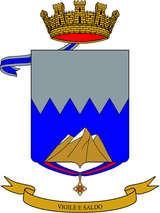Alpini Battalion "Val Brenta"
The Alpini Battalion "Val Brenta" (Italian: Battaglione Alpini "Val Brenta") is an inactive battalion of the Italian Army's mountain infantry speciality, the Alpini, which distinguished itself in combat during World War I and World War II.[2]
| Alpini Battalion "Val Brenta" | |
|---|---|
| Battaglione Alpini "Val Brenta" | |
 Battalion coat of arms | |
| Active | 15 February 1915 - 30 April 1920 27 August 1939 - 31 October 1940 1 July 1963 - 23 August 1986[1] |
| Country | Italy |
| Branch | Italian Army |
| Type | Alpini |
| Part of | Alpine Brigade "Tridentina" |
| Garrison/HQ | Bruneck |
| Motto(s) | "Vigile e saldo"[1] |
| Anniversaries | 2 September 1916 - Defense of Monte Cauriol[1] |
| Decorations | 1x Military Order of Italy 1x Silver Medal of Military Valour[1] |
| Insignia | |
| Alpini gorget patches | |
History
World War I
The battalion was raised on 15 February 1915 with reservists of the Alpini Battalion "Bassano" of the 6th Alpini Regiment. The battalion's name, like the names of all Alpini battalions raised during World War I with first line reservists, was the name of a valley near the active battalion's base; in the Val Brenta battalion's case the Brenta valley, which extends to the north from Bassano. As with all Alpini battalions the recruits for the battalions were drafted exclusively from the area surrounding the battalions base. Initially the battalion fielded the 262nd and 263rd Alpini companies, and received the 274th Alpini Company on 15 December 1916.[2][3]
The Val Brenta battalion's history is intertwined with the history of the 6th Alpini Regiment, with which it served during World War I. During the war the battalion was awarded a Silver Medal of Military Valour for the defense of Monte Cauriol on 1-5 September 1916 against repeated Austro-Hungarian, during which the battalion lost seven officers and more than 250 soldiers. After the war the battalion was disbanded on 30 April 1920.[2]
World War II
The battalion was reformed on 27 August 1939 and participated in the Italian invasion of France in June and July 1940. Afterwards the battalion was once more disbanded on 31 October 1940 and the battalion's reservists dismissed.[2]
Cold War

On 1 July 1963 the XXIII Alpini Fortification Battalion in Innichen was renamed Alpini Battalion "Val Brenta". The battalion was part of the Alpine Brigade "Tridentina" and tasked with tasked to man fortifications in the upper Puster valley, which the Italian Army (correctly) assumed to be one of two main directions of a possible Warsaw Pact advance. Initially the Val Brenta fielded three active and five reserve companies, the latter of which had arrived 30 June 1964 from the disbanded Alpini Battalion "Val Leogra". On 1 November 1976 the Alpini Battalion "Val Cismon" of the Alpine Brigade "Cadore" was disbanded and its four companies transferred to the Val Brenta, which now fielded three active and nine reserve companies with a wartime strength of more than 2,200 men. On 1 July 1979 the Val Brenta received the 253rd Alpini Company from the disbanded Alpini Battalion "Val Chiese" of the Alpine Brigade "Orobica". The structure of the battalion was now:















- Type A = fortification fully equipped, provisioned and manned; close support platoon onsite
- Type B = fortification fully equipped, provisioned and manned; close support platoon off site
- Type C = fortification fully equipped; provisions, crew and close support platoon off site
The fortifications the Val Brenta would man in case of war with the Warsaw Pact had been build as Alpine Wall in the early stages of World War II. The Val Brenta was to man the following bunker systems with the aim to deny enemy forces passage through the Puster and Piave valleys:
- Winnebach: 9 bunker, 203 men, 262nd Alpini Company (Italian Wikipedia: Sbarramento Prato Drava)
- Vierschach: 6 bunker, 180 men, 263rd Alpini Company (Italian Wikipedia: Sbarramento Versciaco)
- Kreuzbergpass: 7 bunker, 247 men, 264th Alpini Company (Italian Wikipedia: Sbarramento Passo Monte Croce Comelico)
- Val Frison: 3 bunker, ? men, 265th Alpini Company (Italian Wikipedia: Sbarramento Val Frison)
- Toblach: 10 bunker, 304 men, 274th Alpini Company (Italian Wikipedia: Sbarramento Dobbiaco)
- Landro Nord: 3 bunker, 150 men, 277th Alpini Company (Italian Wikipedia: Sbarramento della Val di Landro)
- Prags: 2 bunker, 116 men, 347th Alpini Company (Italian Wikipedia: Sbarramento di Braies)
- Antholz: 6 bunker, 164 men, 351st Alpini Company (Italian Wikipedia: Sbarramento Anterselva)
- Olang: 10 bunker, 373 men, 352nd Alpini Company (Italian Wikipedia: Sbarramento Rasun-Valdaora)
- Percha: 7 bunker, 223 men, 353rd Alpini Company (Italian Wikipedia: Sbarramento di Perca)
- Saalen: 4 bunker, 113 men, 354th Alpini Company (Italian Wikipedia: Sbarramento di Sares)
- Mühlbach: 5 bunker, 141 men, 355th Alpini Company (Italian Wikipedia: Sbarramento Chiusa di Rio)
With fixed fortifications becoming obsolete the battalion was disbanded on 23 August 1986 with only the 262nd Alpini Company remaining on active duty. After the battalion was disbanded its war flag was transferred to the shrine of the flags at the Vittoriano in Rome.[2][1]
External links
Source
- Franco dell'Uomo, R. di Rosa: "L'Esercito Italiano verso il 2000 - Volume Secondo - Tomo I", Rome 2001, Stato Maggiore dell'Esercito - Ufficio Storico, page: 504
References
- "Le Feste dei Reparti - Settembre". Italian Army. Retrieved 7 December 2019.
- "Battaglione Alpini Val Brenta". vecio.it. Retrieved 7 December 2019.
- "Val Brenta". Fronte del Piave. Retrieved 6 January 2019.
- F. dell'Uomo, R. di Rosa (2001). L'Esercito Italiano verso il 2000 - Vol. Secondo - Tomo I. Rome: SME - Ufficio Storico. p. 504.